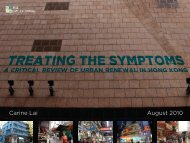Untitled - Civic Exchange
Untitled - Civic Exchange
Untitled - Civic Exchange
You also want an ePaper? Increase the reach of your titles
YUMPU automatically turns print PDFs into web optimized ePapers that Google loves.
SUSTAINABLE TRANSPORT IN HONG KONG: DIRECTIONS AND OPPORTUNITIES<br />
The increase in the use of heavy goods vehicles may be associated<br />
with the increase in cross-border trade with mainland China,<br />
particularly the movement of shipping containers by lorry. The<br />
decline in the use of light goods vehicles may reflect the decline<br />
in manufacturing in Hong Kong. These trends are illustrated in<br />
Figure 6.2, which shows by value the overall increase in the reexport<br />
of goods from and to mainland China - by far the largest<br />
portion of the trade - and the decline in domestic exports, i.e.,<br />
goods made in Hong Kong. 193<br />
Figure 6.3 shows how these economic trends are reflected in the<br />
number of vehicles crossing the border. The number of goods<br />
vehicles other than container lorries has remained relatively<br />
steady at about 4.5 million crossings per year. However, the<br />
number of container lorry crossings increased almost fourfold<br />
between 1991 and 2001. 194<br />
The 4.4 million border crossings by container vehicles and the 4.7<br />
million crossings by other goods vehicles in 2001 illustrated in Figure 6.3 indicate an average of about 12,100<br />
and 13,000 crossings respectively per day. More than 60% of the crossings by goods vehicles and almost 80%<br />
of the crossings by container lorries are made at<br />
Lok Ma Chau crossing point. Of the three road<br />
crossing points into mainland China, Lok Ma<br />
Chau is the nearest to the Hong Kong port. It is<br />
also open for the most hours per day, from 6:30<br />
a.m. to midnight.<br />
In relation to the total volume of Hong Kong<br />
traffic, the amount of road activity contributed<br />
by cross-border traffic is small, perhaps one<br />
million vehicle-kilometers per day of the six<br />
million vehicle-kilometers involving goods<br />
vehicles and 32 million vehicles-kilometers<br />
traveled overall. 195 However, cross-border<br />
traffic is likely to account for a large proportion<br />
of vehicles on the roads between the port and<br />
the border. 196 The exact proportion may not be<br />
known until results from a 2003 Transport<br />
Figure 6.2 Value of domestic exports<br />
and re-exports involving mainland<br />
China, 1990-2000<br />
Exports in billions of 1990 HK$<br />
1,000<br />
800<br />
600<br />
400<br />
200<br />
0<br />
Re-exports to/from<br />
mainland China<br />
Domestic exports<br />
1990 1992 1994 1996 1998 2000<br />
Figure 6.3 Border crossings by container lorries and other<br />
goods vehicles (left-hand scale) and container traffic leaving<br />
the port by road (right-hand scale)<br />
Tho usa nds of ro ad v ehi cle s cros sin g bo und ary<br />
6,000<br />
5,000<br />
4,000<br />
3,000<br />
2,000<br />
1,000<br />
Goods vehicl es<br />
Container vehicles<br />
Containers<br />
1991 1993 1995 1997 1999 2001<br />
12,000<br />
10,000<br />
8,000<br />
6,000<br />
4,000<br />
2,000<br />
Th ou san ds of TEUs enteri ng or<br />
lea vin g th e po rt by r oad<br />
58<br />
193<br />
The data in Figure 6.2 are chiefly from CSD (2000), Hong Kong Annual Digest of Statistics.<br />
194 The data in Figure 6.3 are chiefly from the Transport Department (Dec 2001), Monthly Traffic and Transport<br />
Digest, Hong Kong: HKSAR Government; and Port and Maritime Board (PMB) (2002), Summary Statistics on<br />
Port Traffic in Hong Kong (as of December 2001), Hong Kong: HKSAR Government.<br />
195 The estimate of 32 million vehicle-kilometers (vkm) is in Transport Department (2000), Annual Traffic Census<br />
2000, Hong Kong: HKSAR Government. Other vkm estimates in this paragraph were made by Richard Gilbert.<br />
196 For example, heavy goods vehicles comprised 0.6% of road vehicles licensed in Hong Kong in 2001 but<br />
amounted to 8.8% of vehicles using the Tai Lam tunnel, which lies between the port and the border. Transport<br />
Department (Dec 2001), Monthly Traffic and Transport Digest, Hong Kong: HKSAR Government.

















